A Private Tour today, and a request to visit the Brecks. It was a birthday gift between friends, so a relaxed day of birding was in order.
We started at Lynford Arboretum. Firecrest was a key target, which was a good thing as there have been several singing in recent days. In the walled garden. a Grey Wagtail was singing but remained stubbornly out of view. Lots of Siskin buzzed around in the trees. We walked up past the gate, which was very quiet again – no food in the feeders and no birds, apart from a couple of hungry Chaffinches.
Thankfully we didn’t have to go too much further before we heard our first Firecrest singing. It was high up in a fir tree at first, and we were looking into the light, but we could see it flitting around. While we tried to move round to the other side it sneaked out behind us and over to another conifer. It gave away its new hiding place by singing again! The light was better this time, but it was still hard to see in the dense branches. Then it did the decent thing and flew out into a deciduous tree – the leaves are only now starting to burst into like so it was much easier to see there. We got a really good look at its face pattern, the white supercilium and black eyestripe, as well as the bronzey yellow patch on the side of its neck which positively glowed in the morning sun.
Walking round the Arboretum, we could hear the Hawfinches calling. But they flew overhead and disappeared into the fir trees where we couldn’t see them. We had all seen the Hawfinches well already over the winter, so no one was too interested in chasing round after them in the trees, so we left them to it.
Further on, we could hear another two Firecrests singing, very close to each other. The first was in a very dense, dark conifer – we could hear it, but couldn’t see it. Eventually it came out onto the edge and we got an even better look at this one, contrasted against the dark foliage. While we were watching it, a smart male Siskin came and perched right above our heads, rather annoyed that we were paying too much attention to the Firecrest!
 Siskin – this smart male perched above our heads
Siskin – this smart male perched above our heads
We wanted to explore the wilder areas beyond the formal Arboretum today. We walked down around the lake, stopping to admire a Little Grebe on the water which kept diving as it tried to swim away from us. A pair of Nuthatches were in the trees beside the water, the male sitting out in the top calling while the female fed quietly below.
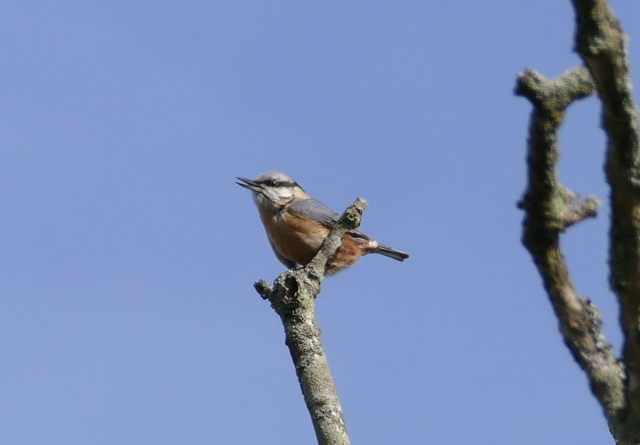 Nuthatch – calling loudly from the treetop
Nuthatch – calling loudly from the treetop
By this stage the wind was picking up, so we sought some shelter. There were lots of birds in the woodland. We heard a couple of Blackcap singing from the depths of the trees, and lots of Chiffchaffs. There were plenty of tits flicking around in the bushes, plus the odd Treecreeper and Goldcrest. We could also hear yet another Firecrest singing. We had hoped that we might pick up some woodpeckers – we heard a distant Green Woodpecker calling, but otherwise it was all quiet in the wind. Then we headed back to the car, pausing briefly to note our fifth singing Arboretum Firecrest of the morning near the car park.
We drove into the Forest and headed off along a ride to a large clearing. On our way, we stopped to listen to a pair of Firecrests in the trees beside the path – it really was a Firecrest day today!
We had hoped we might get lucky and see a Goshawk, but the wind was an issue. There were no raptors at all in sight when we arrived. After a while, a single Sparrowhawk flew past above the trees. Then a couple of Buzzards appeared, but they were not going up very high today. Eventually a Goshawk did show itself, circling very distantly up above the trees, but as we tried to get everyone on it in the scope it disappeared again. A short while later, it did exactly the same thing, frustratingly closer. Then the wind picked up even further and the little activity there had been died off completely. It was not going to be our day for raptors.
We did better with passerines. A Woodlark appeared as soon as we got to the clearing, flying past calling. It landed on a fence post and we got a good look at it in the scope. We walked along the path and could see a pair on one side, out in the clearing, and a single bird on its own which flew in and landed on the other side. When it flew again, it was joined by a second Woodlark, presumably a female coming up from the nest, making a second pair.
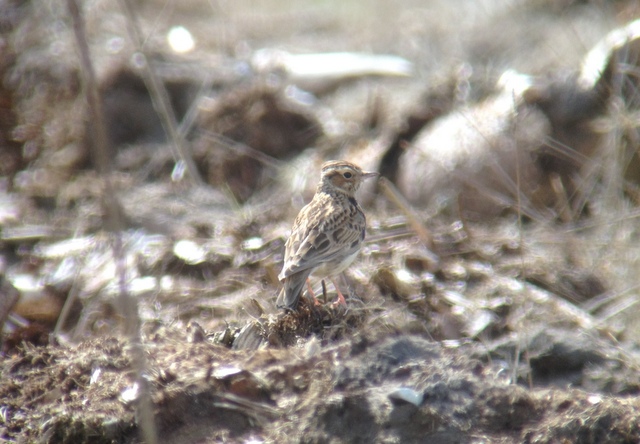 Woodlark – two pairs were in the clearing today
Woodlark – two pairs were in the clearing today
We were then surprised by a couple of buzzy calls overhead, and two small birds dropped into a pine tree on the edge of the clearing. We could see them in the scope, sitting there half hidden amongst the branches. A pair of Tree Pipits – a real surprise. Tree Pipits are summer visitors to the Forest, and birds heading further afield have been on the move along the coast in the last couple of days, but these are the first we have seen in the Brecks this year. After we had turned to look at a distant raptor, there was no sign of them in the pine and we couldn’t find them feeding on the edge of the trees either. They may just have been passing over and dropped down to try to find shelter from the wind. They could have been heading for a different part of the Forest. Still, a really good bird to see.
As the wind picked up, we headed round to the sheltered side of the clearing, in the lee of the trees. The second pair of Woodlarks flew in and landed nearby, before coming out onto the path right in front of us. They were clearly trying to get out of the wind as well. We had great views as we watched them collecting food – getting their bills full before flying out into the clearing and dropping down. They returned a short while later and started again, so they were obviously feeding young (we had seen the first pair carrying food as well, earlier in the week). At one point, we saw one of the Woodlarks put down the food it had collected to one side while it pecked at something in the bare earth on the side of the track, before picking up its load of food again. It was fantastic to watch them like this.
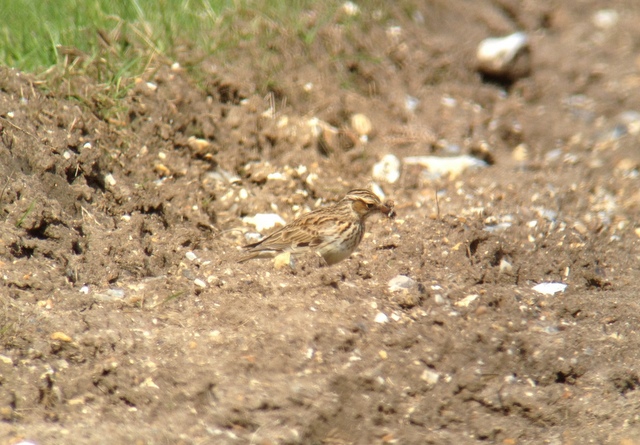 Woodlark – one pair was collecting food right in front of us on the path
Woodlark – one pair was collecting food right in front of us on the path
By now, it was getting on for lunch time, so we started to walk back. Before we had left the clearing though, a Swallow came in over the trees and made a low pass over the bare ground. It was probably difficult to find food to sustain it on its journey above the trees today, so it saw the clearing as a good opportunity try to find some insects close to the bare ground.
We parked up in a convenient car park for lunch, where we could find some shelter. It was beautiful sunshine, and warm out of the wind. While we ate, a little Weasel ran across the car park into the verge. It came out again a short while later, empty handed, but stood for a while out in the open, before racing off again.
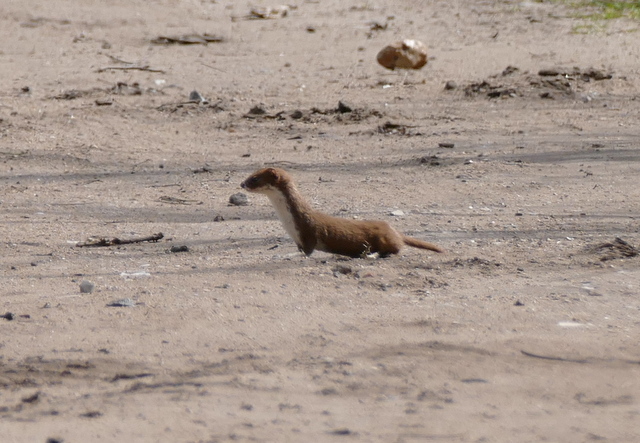 Weasel – ran across the car park at lunch time
Weasel – ran across the car park at lunch time
In the afternoon, we headed for Santon Downham. We walked down to the river and headed west along the bank. Just below the bridge, we heard a Brambling calling from the bushes. Unfortunately, we couldn’t see it until it flew across the river and disappeared over the other side. As it flew, we could see it was a smart male, with a good black head.
We had been talking about spring butterflies and how most of the species we had seen were those which overwinter as adults and simply reappear on the first warm days of spring – butterflies such as Brimstone, Comma, Peacock and Small Tortoiseshell. A little way further along the bank, a smart male Orange Tip fluttered past, the first of the butterflies to emerge from a chrysalis – and a real sign that spring has arrived.
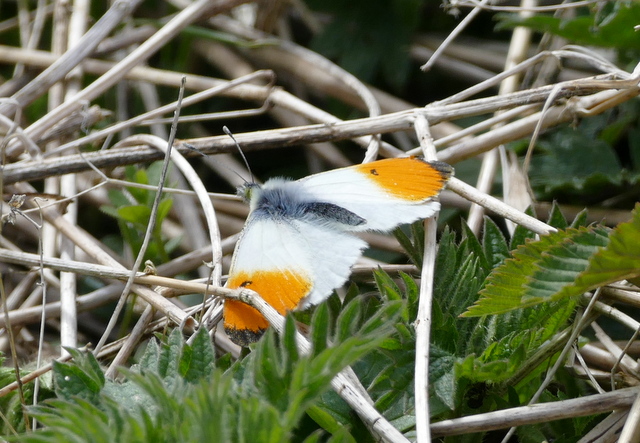 Orange Tip – a sure sign that spring is really here
Orange Tip – a sure sign that spring is really here
Continuing along the path, we could see a duck asleep on the other bank. A quick look through binoculars confirmed it was a female Mandarin. It woke up briefly, so we could see its white eye-ring and eye-stripe, before tucking its head back in. There have been several along the river bank in recent weeks, mostly in pairs, but this bird appeared to be on its own.
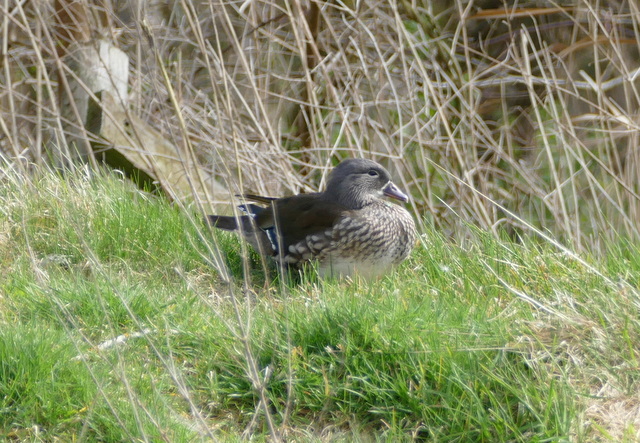 Mandarin – this female was (mostly) asleep on the river bank
Mandarin – this female was (mostly) asleep on the river bank
As we watched it, we could see movement beyond it, where the bank sloped away behind and we couldn’t see. Then a head appeared – it was the male Mandarin. He was clearly feeling a lot more shy than the female, as the head kept disappearing before popping up again and having a look round. Eventually he edged forward and sat down next to her, but was still not brave enough to show himself properly, in all his splendour!
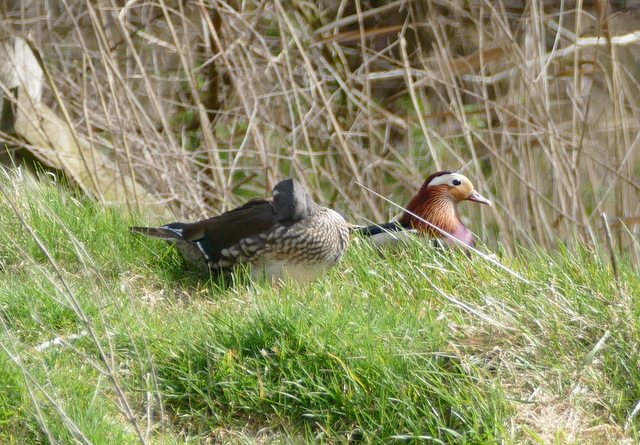 Mandarin – the male was more reluctant to show himself today
Mandarin – the male was more reluctant to show himself today
Otherwise, it was quiet along the river – perhaps not surprising, given the way the wind was gusting through the trees. There were no woodpeckers of any species calling or drumming, though it was always a bit speculative to try in the middle of the day. Early morning is usually best. We heard the odd Nuthatch piping and we did find a nice pair of Marsh Tits calling to each other. It was lovely down by the river but, given the lack of activity, we decided to head back.
We had almost reached the bridge, when we heard a Redpoll singing. A scan of the bushes revealed a pair of Lesser Redpoll which had obviously just been down to bathe, the male sporting a bright red breast. Unfortunately, just as we tried to get the rest of the group on them, they disappeared. How annoying. By the bridge, we heard a Grey Wagtail calling as it flew along the river and thankfully it was a little more accommodating – it landed on the river bank just below the bridge, where we could see it feeding along the shore.
We had time for one last stop, so we headed over to Weeting Heath. When we arrived, we were warned that the Stone Curlews were not showing – they seemed to have sensibly chosen to hunker down out of the wind. We walked round to the West Hide anyway, stopping briefly to admire the Long-tailed Tit nest nearby, and settled in. By now it had clouded over a little and the afternoon was getting on – Stone Curlews are always more active early and late in the day, so we felt we might be in with a good chance. And it didn’t take long before one stood up and showed itself.
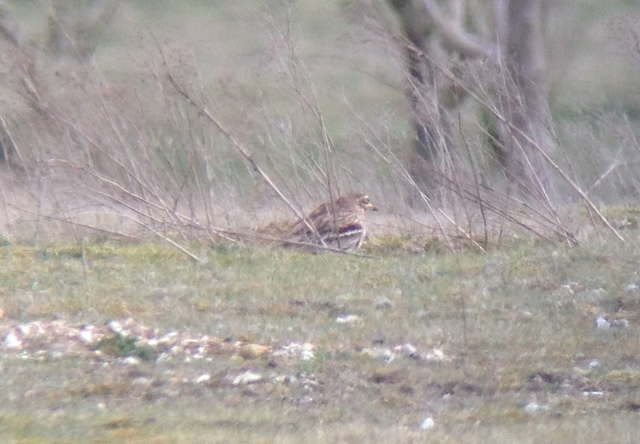 Stone Curlew – we saw a pair displaying at Weeting today
Stone Curlew – we saw a pair displaying at Weeting today
The Stone Curlew seemed a little uncertain at first. It stood up and we could see it calling – even if we couldn’t hear it in the wind. Then it sat down again, and we could only just see the top of its head. After a while, it finally stood up properly and began to walk quickly along the ridge. Suddenly a second Stone Curlew appeared with it and the first bird began to display, bowing deeply and raising its tail high. It was well worth the wait, and we finally got a really good look at them through the scope. When they both sat down again, we decided it was time to call it a day and headed for home.
















